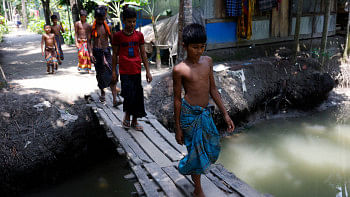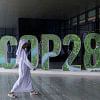Why the Himalayan Third Pole is crucial in climate governance

The future of the Himalayan region is linked inextricably with three Cs: Climate, Connectivity, and Community. Of these, perhaps the climate cluster is primus inter pares among them; the other two feed into it as they walk hand in hand, weaving into our lives and existence, and affecting the survivability not only of our planet but also of our own species.
The UN secretary general, during a press conference at the UN in July 2023, famously said, "Humanity is in the hot seat… Climate change is here. It is terrifying. And it is just the beginning… The era of global warming has ended; the era of global boiling has arrived… The air is unbreathable. The heat is unbearable… And the level of fossil fuel profits and climate inaction is unacceptable.
Leaders must lead… No more hesitancy. No more excuses. No more waiting for others to move first. There is simply no more time for that."
At COP28 in Dubai, he asserted, "We are miles from the goals of the Paris Agreement—and minutes to midnight for the 1.5-degree limit… We cannot save a burning planet with a firehose of fossil fuels… So, allow me to have a message for fossil fuel company leaders: your old road is rapidly ageing. Do not double down on an obsolete business model."
The UN secretary general is perhaps the conscience of humanity, but humanity appears to be paying scant attention to him.
The Hindu Kush Himalaya region is of seminal importance to climatic changes affecting our planet. Stretching as it does 3,500 kilometres across, from China in the east to Afghanistan in the west, it is referred to by climatologists as the world's "Third Pole," because of the vast ice contained there. Together with the oceans, it comprises over 71 percent of Planet Earth. The vast forested areas scattered across our seven continents, the hills and valleys through which rivers flow and which connect the mountains to the oceans, the ice caps of the Arctic, Antarctic, and the Hindu Kush Himalaya comprise one holistic ecosystem that has sustained Planet Earth for millennia, through maintaining an equilibrium between themselves, governing the variations in the climate through a natural process of balancing air flows and precipitation cycles.
The Himalayan glaciers help sustain several major rivers in Asia. These rivers provide nearly two billion people with drinking water and irrigation systems used for farming. Additionally, they hold the potential for harvesting hydropower for millions of people living in South and Southeast Asia. They play a part in regulating the regional climate, as they influence monsoon patterns and help to ensure an ecological balance in the surrounding areas.
ALL scientific data in recent decades point to an alarming decrease in ALL these three ice poles. According to the International Centre for Integrated Mountain Development (ICIMOD), glaciers in the Hindu Kush Himalaya are melting at unprecedented rates and could lose up to 75 percent of their volume by the end of the century. Some other estimates project a higher volume of loss. This would result in dangerous flooding and water shortages for nearly two billion people who live downstream of the rivers that originate in the Himalayas, with flash floods and avalanches becoming commonplace events. This would also seriously adversely affect availability of fresh water for at least 240 million people who live in the Himalayan region, as well as 1.65 billion who live downstream of the 12 rivers originating from the Himalayas.
Current adaptation measures have proven to be grossly inadequate. Data reveal that the Mt Everest glaciers have lost 2,000 years of ice in just 30 years, while the Himalayan glaciers have disappeared 65 percent faster since 2010 than in the previous decade. These losses of glaciers, snow, and permafrost are unprecedented and perhaps largely irreversible. Glaciers across the entire Himalayan region will lose 30-50 percent of the volume by 2100 at 1.5 degrees Celsius or 2 degrees Celsius warming above pre-industrial levels. However, glaciers in eastern Himalayas, Nepal and Bhutan will likely lose up to 75 percent at 3 degrees Celsius warming and 80 percent at 4 degrees Celsius warming.
Flows in the region's 12 river basins, including the Ganges, Indus and Mekong, are likely to peak around the mid-century with adverse consequences for the more than 1.6 billion people who depend on these waters. The rise of waters in these rivers from increased glacier melt will not be manifested as a steady flow, but as possibly violent flash floods from bursting of glacier lake dams that store huge quantities of fresh water. In 2022, record high temperatures in March and April in the high peaks of Gilgit-Baltistan resulted in abnormally rapid melting of the Shisper Glacier, creating a lake that swelled and burst through a glacial dam. A torrent of water and debris flooded the valley below, damaging fields and houses, wrecking two power plants, and washing away parts of the main highway and a bridge connecting Pakistan and China. At least 200 glacier lakes are identified as being in a dangerous state and in danger of bursting. However, after the initial deluge following such outbursts, water supplies of rivers will dwindle exponentially thereafter.
The consequences of losing this cryosphere are unimaginably foreboding. According to the World Meteorological Organization, the annual mean global near-surface temperature for each year between 2023 and 2027 is predicted to be between 1.1 degrees Celsius and 1.8 degrees Celsius higher than the 1850-1900 average, skewing snowfall and rainfall patterns increasingly out of sync with seasonality, adversely affecting all life species. There are reports of yaks having died due to a lack of food in India, Nepal and Bhutan, leaving farmers with huge income losses. Other unique species also threatened by adverse changes to the climate of the diverse ecosystems include tropical and subtropical rainforests and temperate coniferous forests. Fourteen species of butterflies have already reportedly become extinct from the Murree Hills of Pakistan, while endemic frog species are among the most impacted by climate change as they experience breeding problems and developmental deformities.
The loss of the Himalayan ice cap has grave consequences, as described above, not only for the people of the Himalayan region, but also for those living in the plains and the deltaic region and the Bay of Bengal as well. It will trigger a cascading set of chain reactions adversely impacting all parameters of human security: water security, food security, health security, habitat security, and livelihood security. At the very local level in Bangladesh, which connects the Himalayan mountains with the Indian Ocean through the Bay of Bengal, our ambitious development plans, such as the Mujib Climate Prosperity Plan 2041 or the even more ambitious Delta Plan 2100, will come crashing down on us, with unimaginable consequences for the country and the region.
While climate change is a global problem, it is increasingly clear that efforts so far toward a global solution, in which every player enthusiastically participates, are not going to happen any time soon. We are all aware that the aeroplane we are on is going to crash into a mountain soon. While many countries are already working desperately to stave off disaster, woefully they all work in silos. Our ready embrace of the Westphalian model of nation-state and state sovereignty with inviolable borders led to our partitioning not only our lands but also the vast ecologically important commons that constitute our shared hydrosphere and natural commons. Most perniciously, it partitioned our very mindsets.
Commons that can only thrive and survive and continue to sustain us are dying because the ecological integrity that had held them together—the mountains, the valleys, the forestry, the wildlife—and kept them healthy for millennia, are now hostage to different versions of "resource nationalism." While European Westphalian states, from whom we blindly accepted the model of state sovereignty at our independence, learnt long ago to pool their sovereignty to manage their shared ecosystems, and in the process also arrived at innovative ways of deriving benefits from these commons without undermining their national or cultural integrity, our stubborn reluctance to go that route for fear of ceding sovereignty is actually slowly stifling the life of these ecosystems.
In South Asia, the partition of the subcontinent spawned in us this accursed "Partition Syndrome," severing connectivity that used to be the driver of trade, economic development, as well as movement of not only humans, but other species across natural migration borders, and goods and services, ideas and cultural exchanges. It is this same syndrome that keeps us prisoners from engaging in cooperation that would address our development dilemmas and also translate into climate mitigation measures of beneficial consequence for all.
We all need power as fuel for our industrial engines to chug at speed, without hiccups. While we in the region have a vast but latent, untapped reservoir of clean renewable energy that we could transition to very easily if we wanted to, we have all fallen to being heavily dependent on imported fossil fuels, which are now clearly identified as the darkest culprit in global warming, and for which we pay exorbitant costs. Our ambitions are huge, but our quick realisation of those are stymied by an acute shortage of reliable power—and our singular inability, or sheer unwillingness, to work on regional collaborative ventures.
I had once dreamt, and openly and actively espoused, that at least in the Bangladesh, Bhutan, India, Nepal (BBIN) sub-region of the subcontinent, we could collaboratively move towards putting in place an interlinked power grid of symbiotic interdependence that would not only be derived from clean, renewable energy, but also impel us on water basin management in a holistic manner beneficial to all. But our movement in that direction has been inordinately long and slow. The recent summit level decision between Nepal and India to identify and upgrade a dedicated grid line in India to connect with Nepali, Bhutanese and Bangladeshi grids is a huge leap forward, but we need to move fast to operationalise it. Questions related to the origin of investment funds for such power projects continue to bedevil this process. They can be overcome by entering into joint venture schemes with other partners, like international development agencies or acceptable private sector, or the countries together forming a joint stock company and raising monies regionally through clean energy bonds.
We must also restore those severed connectivities, to restore trust among the partitioned peoples of the subcontinent. But we must not forget that at the heart of those connectivities are the communities of peoples who populate our lands. We must make them active participants in such activities.
While a global operational solution to our global climate disaster appears to be a stubbornly elusive dream, the myriad local and national solutions that we are striving at can be given greater relevance through synergising those activities in a collaborative manner, through cooperation across communities within the nation states, and then enlarging and expanding them to collaboration between states in the region. The new globalisation has to be a bottom-up, community-level fanning outwards, grassroots-spawned process.
This column is based on the author's keynote address at the inaugural session of the Himalayan Future Forum Conference, held in Kathmandu, Nepal on February 16, 2024.
Tariq Karim is a retired ambassador of Bangladesh, and is currently the director of the Centre for Bay of Bengal Studies at Independent University, Bangladesh (IUB), and concurrently distinguished visiting research fellow at the Institute of South Asian Studies in the National University of Singapore (NUS).
Views expressed in this article are the author's own.
Follow The Daily Star Opinion on Facebook for the latest opinions, commentaries and analyses by experts and professionals. To contribute your article or letter to The Daily Star Opinion, see our guidelines for submission.

 For all latest news, follow The Daily Star's Google News channel.
For all latest news, follow The Daily Star's Google News channel. 











Comments